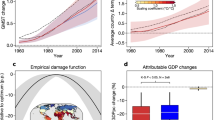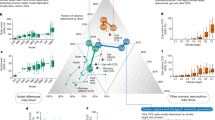Abstract
The Brazilian Proposal for setting emission targets is based on attribution of responsibility for climate change due to historical emissions of greenhouse gases. Numerical models are used to calculate the temperature increase due to past emissions of greenhouse gases, and to partition the warming among nations or groups of nations. When non-linearities are included in the models, there are different approaches that can be used to partition global warming into regional or national contributions, and the methods give different results. Here we describe and compare seven different approaches for attributing indicators of climate change for regional emissions. We illustrate these methods with simple and realistic examples, and discuss their characteristics. Of the seven attribution methods discussed, two (the marginal and time-sliced methods) are seen as best-suited for attribution of climate change. Differences between attribution methods are typically up to a few percent for the examples considered, with differences greatest for regions with emission time histories that differ most from the average. The range due to choice of attribution method in the relative contributions of temperature change in 2000 is typically around one fifth of the range generated when other choices such as different models, forcing agents, feedbacks and other assumptions are included.
Similar content being viewed by others
References
Andronova, N. and Schlesinger, M.: 2004, ‘Importance of Sulfate Aerosol in Evaluating the Relative Contributions of Regional Emissions to the Historical Global Temperature Change’Mitigation Adaptation Strateg Global Change in press.
den Elzen, M.: 1999, ‘Report on the Expert Meeting on the Brazilian Proposal: Scientific Aspects and Data Availability’. http://unfccc.int/sessions/workshop/010528/mrep1999.pdf.
den Elzen, M., Berk, M., Schaeffer, M., Olivier, J., Hendriks, C. and Metz, B.: 1999, ‘The Brazilian Proposal and Other Options for International Burden Sharing: An Evaluation of Methodological and Policy Aspects Using the FAIR Model’. RIVM Report 728001011/1999, (RIVM, The Netherlands).
den Elzen, M. and Schaeffer, M.: 2002, ‘Responsibility for Past and Future Global Warming: Uncertainties in Attributing Anthropogenic Climate Change’Climatic Change54, 29–73.
den Elzen, M., Schaeffer, M. and Eickhout, B.: 2002, ‘Responsibility for Past and Future Global Warming: Time Horizon and Nonlinearities in the Climate System’.RIVM Report 728001022/2002 http://www.rivm.nl/bibliotheek/rapporten/728001022.pdf, (RIVM, The Netherlands).
Enting, I.: 1998, Attribution of Greenhouse Gas Emissions, Concentrations and Radiative Forcing, CSIRO Atmospheric Research Technical Paper No. 38. CSIRO, Australia, Electronic edition from: http://www.dar.csiro.au/publications/enting 2002a.pdf.
Enting, I. and Law, R.: 2002, Characterising Historical Responsibility for the Greenhouse Effect, CSIRO Atmospheric Research Technical Paper No. 41. CSIRO, Australia. Electronic edition from: http://www.dar.csiro.au/publications/enting2002a.pdf.
Enting, I. and Trudinger, C.: 2002, Modelling Earth System Change I:Validating Parameterisations for Attribution Calculations, CSIRO Atmospheric Research Technical Paper No. 56. CSIRO, Australia, Electronic edition from: http://www.dar.csiro.au/publications/enting2002b.pdf.
Harvey, D., Gregory, J., Hoffert, M., Jain, A., Lal, M., Leemans, R., Raper, S., Wigley, T. and de Wolde, J.: 1997, ‘An Introduction to Simple Climate Models used in the IPCC Second Assessment Report’Technical Report No. 2, Intergovernmental Panel on Climate Change.
Höhne, N. and Harnisch, J.: 2002, ‘Evaluating Indicators for the Relative Responsibility for Climate Change—Alternatives to the Brazilian Proposal and Global Warming Potentials’In:Non-CO2 Greenhouse Gases, NCGG-3. Milpress, Maastricht.
Houghton, J. T., Meira Filho, L. G., Bruce, J., Lee, H., Callander, B. A., Haites, E., Harris, N. and Maskell, K.: 1995, ‘Climate Change 1994: Radiative Forcing of Climate Change and an Evaluation of the IPCC IS92 Emission Scenarios’Cambridge University Press, Cambridge.
IPCC: 1999, Special Report on Aviation and the Global Atmosphere, Cambridge University Press Cambridge.
IPCC: 2001, Climate Change 2001: The Scientific Basis, Cambridge University Press Cambridge.
Joos, F., Bruno, M., Fink, R., Siegenthaler, U., Stocker, T. F., Le Quéere, C. and Sarmiento, J. L.: 1996, ‘An Efficient and Accurate Representation of Complex Oceanic and Biospheric Models of Anthropogenic Carbon Uptake’Tellus48B, 397–417.
Joos, F., Plattner, G.-K., Stocker, T.F., Marchal, O. and Schmittner, A.: 1999, ‘Global Warming and Marine Carbon Cycle Feedbacks on Future Atmospheric CO2’Science284, 464–467.
Meira Filho, L. G. and Miguez, J. G. D.: 1998,Note on the Time Dependent Relationship Between Emissions of Greenhouse Gases and Climate Change, Ministry of Science and Technology: Brasilia, Brazil, Electronic edition from: http://www.mct.gov.br/clima/ingles/negoc/pdf/proposta.pdf.
Nakicenovic, N., Alcamo, J., Davis, G., de Vries, B., Fenhann, J. Gaffin, S., Gregory, K., Gröbler, A., Jung, T. Y., Kram, T., Emilio la Rovere, E., Michaelis, L., Mori, S., Morita, T., Pepper, W., Pitcher, H., Price, L., Riahi, K., Roehrl, A., Rogner, H., Sankovski, A., Schlesinger, M., Shukla, P., Smith, S., Swartt, R., van Rooyen, S., Victor, N. and Dadi, Z.: 2000, ‘Special Report on Emissions Scenarios’IPCC Special Reports.
Olivier, J. G. J. and Berdowski, J. J. M.: 2001, ‘Global Emissions Sources and Sinks’in Berdowski, J. J. M., Guicherit, R. and Heij, B. J. (eds.),The Climate System. A.A. Balkema Publishers/Swets & Zeitlinger Publishers, Lisse, The Netherlands, pp. 33–78.
UNFCCC: 1997,Brazil: Proposed Elements of a Protocol to the United Nations Framework Convention on Climate Change. Presented by Brazil in Response to the Berlin Mandate, http://unfccc.int/resource/docs/1997/agbm/03b.pdf.
UNFCCC: 2001,Scientific and Methodological Aspects of the Proposal by Brazil. Progress Report on the Review of the Scientific and Methodological Aspects of the Proposal by Brazil, Note by the Secretariat, http://unfccc.int/resource/docs/2001/sbsta/inf02.pdf.
UNFCCC: 2002,Methodological Issues: Scientific and Methodological Assessment of Contributions to Climate Change, Report of the Expert Meeting, Note by the Secretariat, http://unfccc.int/resource/docs/2002/sbsta/inf14.pdf.
van Aardenne, J. A., Dentener, F. J., Olivier, J. G. J., Klein Goldewijk, C. G. M. and Lelieveld, J.: 2001, ‘A 1∘× 1∘ Resolution Data Set of Historical Anthropogenic Trace Gas Emissions for the Period 1890–1990’J. Geophys. Res.15, 909–928.
Author information
Authors and Affiliations
Corresponding author
Rights and permissions
About this article
Cite this article
Trudinger, C., Enting, I. Comparison of formalisms for attributing responsibility for climate change: Non-linearities in the Brazilian Proposal approach. Climatic Change 68, 67–99 (2005). https://doi.org/10.1007/s10584-005-6012-2
Received:
Revised:
Issue Date:
DOI: https://doi.org/10.1007/s10584-005-6012-2




